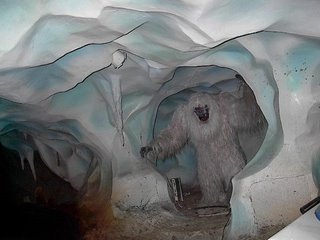The Wendigo

The American Indians had their own tales of the Wendigo, dating back so many years that most who were interviewed could not remember when the story had not been told. The Inuit Indians of the region called the creature by various names, including Wendigo, Witigo, Witiko and Wee-Tee-Go but each of them was roughly translated to mean "the evil spirit that devours mankind". Around 1860, a German explorer translated Wendigo to mean "cannibal" among the tribes along the Great Lakes.
Native American versions of the creature spoke of a gigantic spirit, over fifteen feet tall, that had once been human but had been transformed into a creature by the use of magic. Though all of the descriptions of the creature vary slightly, the Wendigo is generally said to have glowing eyes, long yellowed fangs and overly long tongues. Most have a sallow, yellowish skin but others are said to be matted with hair. They are tall and lanky and are driven by a horrible hunger. But how would a person grow to become one of this strange creatures?
According to the lore, the Wendigo is created whenever a human resorts to cannibalism to survive. In years past, such a practice was possible, although still rare, as many of the tribes and settlers in the region were cut off by the bitter snows and ice of the north woods. Unfortunately, eating another person to survive was sometimes resorted to and thus, the legend of the Wendigo was created.
But how real were (or are) these creatures? Could the legend of the Wendigo have been created merely as a "warning" against cannibalism? Or could sightings of Bigfoot-type creatures have created the stories. While this is unknown, it is believed that white settlers to the region took the stories seriously. At times, they even took the sightings and reports quite seriously and made it enough of the local culture that stories like those of Algernon Blackwood were penned. Real-life stories were told as well and according to the settlers' version of the legend, the Wendigo would often be seen (banshee-like) to signal a death in the community. A Wendigo allegedly made a number of appearances near a town called Rosesu in Northern Minnesota from the late 1800's through the 1920's. Each time that it was reported, an unexpected death followed and finally, it was seen no more.

Even into the last century, Native Americans actively believed in, and searched for, the Wendigo. One of the most famous Wendigo hunters was a Cree Indian named Jack Fiddler. He claimed to kill at least 14 of the creatures in his lifetime, although the last murder resulted in his imprisonment at the age of 87. In October 1907, Fiddler and his son, Joseph, were tried for the murder of a Cree Indian woman. They both pleaded guilty to the crime but defended themselves by stating that the woman had been possessed by the spirit of a Wendigo and was on the verge of transforming into one entirely. According to their defense, she had to be killed before she murdered other members of the tribe.
There are still many stories told of Wendigo's that have been seen in northern Ontario, near the Cave of the Wendigo, and around the town of Kenora, where a creature has been spotted by traders, trackers and trappers for decades. There are many who still believe that the Wendigo roams the woods and the prairies of northern Minnesota and Canada. Whether it seeks human flesh, or acts as a portent of coming doom, is anyone's guess but before you start to doubt that it exists - remember that the stories and legends of this fearsome creature have been around since before the white man walked on these shores. The legends had to have gotten started somehow, didn't they?


0 Comments:
Post a Comment
<< Home